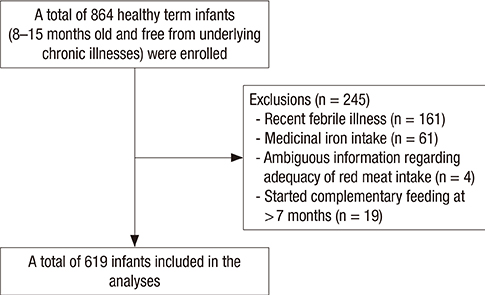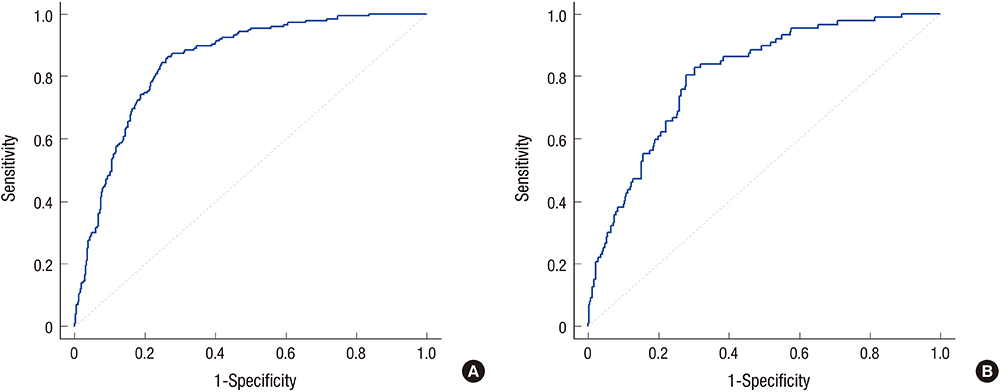J Korean Med Sci.
2017 Jun;32(6):974-984. 10.3346/jkms.2017.32.6.974.
Breastfeeding and Red Meat Intake Are Associated with Iron Status in Healthy Korean Weaning-age Infants
- Affiliations
-
- 1Department of Pediatrics, Seoul National University College of Medicine, Seoul, Korea. jychang7@snu.ac.kr
- 2Department of Pediatrics, Kangwon National University School of Medicine, Chuncheon, Korea.
- 3Department of Pediatrics, Seoul Metropolitan Government-Seoul National University Boramae Medical Center, Seoul, Korea.
- 4Department of Laboratory Medicine, Seoul National University College of Medicine, Seoul, Korea.
- 5Department of Laboratory Medicine, Seoul Metropolitan Government-Seoul National University Boramae Medical Center, Seoul, Korea.
- 6Department of Medical Statistics, Seoul Metropolitan Government-Seoul National University Boramae Medical Center, Seoul, Korea.
- KMID: 2377728
- DOI: http://doi.org/10.3346/jkms.2017.32.6.974
Abstract
- The present study investigated risk factors for iron deficiency (ID) and iron deficiency anemia (IDA) during late infancy, including feeding type and complementary feeding (CF) practice. Healthy term Korean infants (8-15 months) were weighed, and questionnaires regarding delivery, feeding, and weaning were completed by their caregivers. We also examined levels of hemoglobin, serum iron/total iron-binding capacity, serum ferritin, and mean corpuscular volume (MCV). Among 619 infants, ID and IDA were present in 174 infants (28.1%) and 87 infants (14.0%), respectively. The 288 infants with exclusively/mostly breastfeeding until late infancy (BFL) were most likely to exhibit ID (53.1%) and IDA (28.1%). The risk of ID was independently associated with BFL (adjusted odds ratio [aOR], 47.5; 95% confidence interval [CI], 18.3-122.9), male sex (aOR, 1.9; 95% CI, 1.2-2.9), fold weight gain (aOR, 2.6; 95% CI, 1.5-4.6), and perceived inadequacy of red meat intake (aOR, 1.7; 95% CI, 1.0-2.7). In addition to the risk factors for ID, Cesarean section delivery (aOR, 1.9; 95% CI, 1.1-3.2) and low parental CF-related knowledge (aOR, 2.8; 95% CI, 1.5-5.2) were risk factors for IDA. In conclusion, prolonged breastfeeding and perceived inadequacy of red meat intake may be among the important feeding-related risk factors of ID and IDA. Therefore, more meticulous education and monitoring of iron-rich food intake, such as red meat, with iron supplementation or iron status testing during late infancy if necessary, should be considered for breastfed Korean infants, especially for those with additional risk factors for ID or IDA.
Keyword
MeSH Terms
Figure
Cited by 1 articles
-
Differences in Growth and Dietary and Nutrient Intake Patterns by Breastfeeding Status Over One Year Among Korean Children Aged 24–35 Months
Jin A Sohn, Ju Young Chang, Sohee Oh, Jeana Hong
J Korean Med Sci. 2023;38(44):e363. doi: 10.3346/jkms.2023.38.e363.
Reference
-
1. World Health Organization. Iron Deficiency Anaemia: Assessment, Prevention and Control. Geneva: World Health Organization;2001.2. Lozoff B, Beard J, Connor J, Barbara F, Georgieff M, Schallert T. Long-lasting neural and behavioral effects of iron deficiency in infancy. Nutr Rev. 2006; 64:S34–S43.3. Borgna-Pignatti C, Marsella M. Iron deficiency in infancy and childhood. Pediatr Ann. 2008; 37:329–337.4. Yang Z, Lönnerdal B, Adu-Afarwuah S, Brown KH, Chaparro CM, Cohen RJ, Domellöf M, Hernell O, Lartey A, Dewey KG. Prevalence and predictors of iron deficiency in fully breastfed infants at 6 mo of age: comparison of data from 6 studies. Am J Clin Nutr. 2009; 89:1433–1440.5. Male C, Persson LA, Freeman V, Guerra A, van't Hof MA, Haschke F; Euro-Growth Iron Study Group. Prevalence of iron deficiency in 12-mo-old infants from 11 European areas and influence of dietary factors on iron status (Euro-Growth study). Acta Paediatr. 2001; 90:492–498.6. Joo EY, Kim KY, Kim DH, Lee JE, Kim SK. Iron deficiency anemia in infants and toddlers. Blood Res. 2016; 51:268–273.7. Kim SK, Cheong WS, Jun YH, Choi JW, Son BK. Red blood cell indices and iron status according to feeding practices in infants and young children. Acta Paediatr. 1996; 85:139–144.8. Morton SB, Saraf R, Bandara DK, Bartholomew K, Gilchrist CA, Atatoa Carr PE, Baylis L, Wall CR, Blacklock HA, Tebbutt M, et al. Maternal and perinatal predictors of newborn iron status. N Z Med J. 2014; 127:62–77.9. Rawat R, Saha KK, Kennedy A, Rohner F, Ruel M, Menon P. Anaemia in infancy in rural Bangladesh: contribution of iron deficiency, infections and poor feeding practices. Br J Nutr. 2014; 111:172–181.10. Li HT, Trasande L, Zhu LP, Ye RW, Zhou YB, Liu JM. Association of cesarean delivery with anemia in infants and children in 2 large longitudinal Chinese birth cohorts. Am J Clin Nutr. 2015; 101:523–529.11. Domellöf M, Lönnerdal B, Dewey KG, Cohen RJ, Rivera LL, Hernell O. Sex differences in iron status during infancy. Pediatrics. 2002; 110:545–552.12. Chantry CJ, Howard CR, Auinger P. Full breastfeeding duration and risk for iron deficiency in U.S. infants. Breastfeed Med. 2007; 2:63–73.13. Meinzen-Derr JK, Guerrero ML, Altaye M, Ortega-Gallegos H, Ruiz-Palacios GM, Morrow AL. Risk of infant anemia is associated with exclusive breast-feeding and maternal anemia in a Mexican cohort. J Nutr. 2006; 136:452–458.14. World Health Organization. The Optimal Duration of Exclusive Breastfeeding: Report of the Expert Consultation. Geneva: World Health Organization;2001.15. Kramer MS, Kakuma R. Optimal duration of exclusive breastfeeding. Cochrane Database Syst Rev. 2012; CD003517.16. Fewtrell M, Wilson DC, Booth I, Lucas A. Six months of exclusive breast feeding: how good is the evidence? BMJ. 2010; 342:c5955.17. Dewey KG, Cohen RJ, Rivera LL, Brown KH. Effects of age of introduction of complementary foods on iron status of breast-fed infants in Honduras. Am J Clin Nutr. 1998; 67:878–884.18. Fewtrell MS, Morgan JB, Duggan C, Gunnlaugsson G, Hibberd PL, Lucas A, Kleinman RE. Optimal duration of exclusive breastfeeding: what is the evidence to support current recommendations? Am J Clin Nutr. 2007; 85:635S–638S.19. Baker RD, Greer FR; Committee on Nutrition American Academy of Pediatrics. Diagnosis and prevention of iron deficiency and iron-deficiency anemia in infants and young children (0–3 years of age). Pediatrics. 2010; 126:1040–1050.20. Agostoni C, Decsi T, Fewtrell M, Goulet O, Kolacek S, Koletzko B, Michaelsen KF, Moreno L, Puntis J, Rigo J, et al. Complementary feeding: a commentary by the ESPGHAN Committee on Nutrition. J Pediatr Gastroenterol Nutr. 2008; 46:99–110.21. Domellöf M, Braegger C, Campoy C, Colomb V, Decsi T, Fewtrell M, Hojsak I, Mihatsch W, Molgaard C, Shamir R, et al. Iron requirements of infants and toddlers. J Pediatr Gastroenterol Nutr. 2014; 58:119–129.22. Moon JS, Kim JY, Chang SH, Hae CK, Yang HR, Seo JK, Ko JS, Choi KD, Seo JW, Chung HJ, et al. Development of a nutrition questionnaire and guidelines for the Korea National Health Screening Program for infants and children. Korean J Pediatr Gastroenterol Nutr. 2008; 11:42–55.23. Kim YH, Lee SG, Kim SH, Song YJ, Chung JY, Park MJ. Nutritional status of Korean toddlers: from the Korean National Health and Nutrition Examination Survey 2007–2009. Korean J Pediatr Gastroenterol Nutr. 2011; 14:161–170.24. Kim BY, Choi EH, Kang SK, Jun YH, Hong YJ, Kim SK. Weaning food practice and assessment in children with iron deficiency anemia. Korean J Pediatr Gastroenterol Nutr. 2009; 12:215–220.25. Kim SK, Son BK, Choi JW, Pai SW. Anemia and iron deficiency according to feeding practices in infants aged 6 to 24 months. Korean J Nutr. 1998; 31:96–101.26. Yom HW, Seo JW, Park H, Choi KH, Chang JY, Ryoo E, Yang HR, Kim JY, Seo JH, Kim YJ, et al. Current feeding practices and maternal nutritional knowledge on complementary feeding in Korea. Korean J Pediatr. 2009; 52:1090–1102.27. Cameron BM, Neufeld LM. Estimating the prevalence of iron deficiency in the first two years of life: technical and measurement issues. Nutr Rev. 2011; 69:Suppl 1. S49–S56.28. Peyrin-Biroulet L, Williet N, Cacoub P. Guidelines on the diagnosis and treatment of iron deficiency across indications: a systematic review. Am J Clin Nutr. 2015; 102:1585–1594.29. Chang JY, Park JS, Shin S, Yang HR, Moon JS, Ko JS. Mercury exposure in healthy Korean weaning-age infants: association with growth, feeding and fish intake. Int J Environ Res Public Health. 2015; 12:14669–14689.30. Wong AY, Chan EW, Chui CS, Sutcliffe AG, Wong IC. The phenomenon of micronutrient deficiency among children in China: a systematic review of the literature. Public Health Nutr. 2014; 17:2605–2618.31. Konstantyner T, Roma Oliveira TC, de Aguiar Carrazedo Taddei JA. Risk factors for anemia among Brazilian infants from the 2006 National Demographic Health Survey. Anemia. 2012; 2012:850681.32. Yun HJ, Choi EJ, Choi EJ, Hong SY. A comparative study on iron deficiency anemia based on feeding patterns of nine-month-old infants. Korean J Pediatr. 2008; 51:820–826.33. Maguire JL, Salehi L, Birken CS, Carsley S, Mamdani M, Thorpe KE, Lebovic G, Khovratovich M, Parkin PC. TARGet Kids! collaboration. Association between total duration of breastfeeding and iron deficiency. Pediatrics. 2013; 131:e1530–e1537.34. Jonsdottir OH, Thorsdottir I, Hibberd PL, Fewtrell MS, Wells JC, Palsson GI, Lucas A, Gunnlaugsson G, Kleinman RE. Timing of the introduction of complementary foods in infancy: a randomized controlled trial. Pediatrics. 2012; 130:1038–1045.35. Krebs NF, Sherlock LG, Westcott J, Culbertson D, Hambidge KM, Feazel LM, Robertson CE, Frank DN. Effects of different complementary feeding regimens on iron status and enteric microbiota in breastfed infants. J Pediatr. 2013; 163:416–423.36. Wieringa FT, Berger J, Dijkhuizen MA, Hidayat A, Ninh NX, Utomo B, Wasantwisut E, Winichagoon P. Sex differences in prevalence of anaemia and iron deficiency in infancy in a large multi-country trial in South-East Asia. Br J Nutr. 2007; 98:1070–1076.37. Zhou YB, Li HT, Zhu LP, Liu JM. Impact of cesarean section on placental transfusion and iron-related hematological indices in term neonates: a systematic review and meta-analysis. Placenta. 2014; 35:1–8.38. Granado FS, Augusto RA, Muniz PT, Cardoso MA; ACTION Study Team. Anaemia and iron deficiency between 2003 and 2007 in Amazonian children under 2 years of age: trends and associated factors. Public Health Nutr. 2013; 16:1751–1759.39. Andersson O, Hellström-Westas L, Andersson D, Domellöf M. Effect of delayed versus early umbilical cord clamping on neonatal outcomes and iron status at 4 months: a randomised controlled trial. BMJ. 2011; 343:d7157.40. Andersson O, Domellöf M, Andersson D, Hellström-Westas L. Effect of delayed vs early umbilical cord clamping on iron status and neurodevelopment at age 12 months: a randomized clinical trial. JAMA Pediatr. 2014; 168:547–554.
- Full Text Links
- Actions
-
Cited
- CITED
-
- Close
- Share
- Similar articles
-
- A study on the incidence of anemia according to feeding patterns and the status of weaning diet
- Nutrient intakes of infants with atopic dermatitis and relationship with feeding type
- A comparative study on iron deficiency anemia based on feeding patterns of nine-month-old infants
- A study of screening for anemia in 9 month old infants in well baby clinic
- Weaning Food Practice and Assessment in Children with Iron Deficiency Anemia



